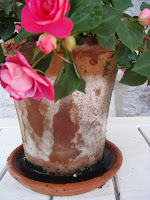Meanwhile...I am going to share more of my favorite container garden ideas with you. Beyond fun!
(I lead a very tame life if talking about flower pots gives me a thrill)
A little whimsy now and then is wonderful in every garden!! (I draw the line, however at cut-out silhouettes of bent-over-butt-crack-gardeners). This pair of work boots, planted with Hens and Chicks is a great example of fun and ingenuity. Not only is it cute, it seems to thrive on neglect; it was planted three years ago and all I have done is water it now and then. Because it is so mobile, I move it wherever I need to fill a spot. Currently, it is hunkered down between a rose bush and lady's mantle.
Don't you love this old bucket? (I think I found it at my favorite hangout, Old Engine Works.) This spot called for a bit of warmth and color, but it needed to be simple to work with this gorgeous table. So I plopped a basket of double impatiens in it and viola!
 You may need to click on this picture to really see what is going on here, but I'll do my best to describe it. This is a rusty old laundry tub. Isn't it fabulous?! I found it at an antique store (which has since gone out of business or I would give you the link) and fell in love! It has drain holes in it already and is sturdy as anything and fills this blank wall space perfectly. Currently I have Russian Red Cannas, purple wave petunias, blue lobilia, purple verbena, variegated licorice, Victoria Blue Salvia, a few zinnias and cosmos. The canna were an experiment because they aren't your typical farmy flower, but I think the height, color and texture work beautifully.
You may need to click on this picture to really see what is going on here, but I'll do my best to describe it. This is a rusty old laundry tub. Isn't it fabulous?! I found it at an antique store (which has since gone out of business or I would give you the link) and fell in love! It has drain holes in it already and is sturdy as anything and fills this blank wall space perfectly. Currently I have Russian Red Cannas, purple wave petunias, blue lobilia, purple verbena, variegated licorice, Victoria Blue Salvia, a few zinnias and cosmos. The canna were an experiment because they aren't your typical farmy flower, but I think the height, color and texture work beautifully. 
This isn't whimsical at all, but I wanted to throw it in today anyway. I had originally purchased these urns to be used in a wedding, so they are a bit on the formal side but gorgeous! (by the way, I found these at The Stone Cottage Gardens) To down play the formality, I used really farmy plants: purple smoke bush (my mom had a BEAUTIFUL one in our yard in Ekin, Indiana and that is farm country, believe me!), my favorite flower of the year - snow princess alyssum - and a variegated filler, I am sorry to say, I have forgotten the name of. (I know, I know, I ended a sentence in a preposition). I have two of these urns and against the background of the dock and pond, they are show stoppers!
Well, I'm off to brave the humidity and do my thing. Enjoy!


















